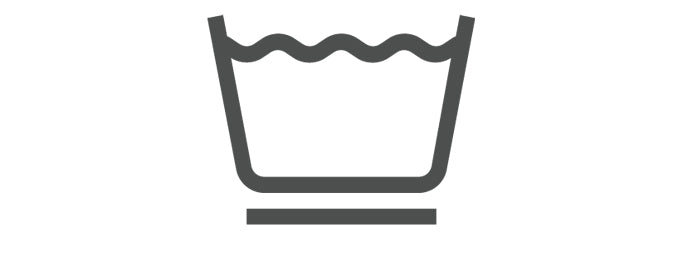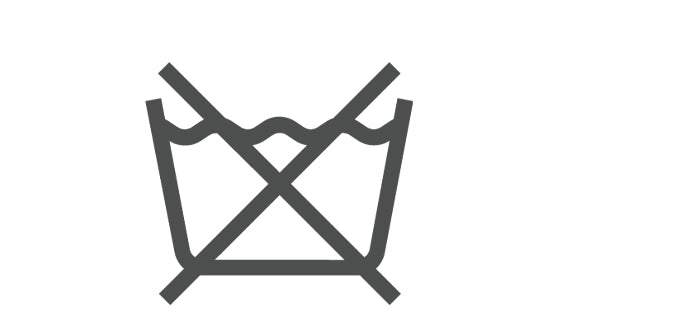
Everybody has experienced the heartbreak of pulling a favourite item of clothing out from the washing machine only to find it shrunken, discoloured or damaged. Knowing what the washing symbols on your labels mean will help you keep your clothes in the best condition.
Each care label on your clothing should tell you what the fabric is made from and feature at least four symbols giving you guidance on washing, bleaching, drying and ironing (in that order), as a general rule:
• Washing tub symbols cover all things washing related (including machine and hand washing)
• Triangles tell you about bleaching
• Squares refer to drying
• The iron gives you the most appropriate ironing setting to use
• Circles tell you about dry cleaning
Basic Instructions On Care Labels
-

This means your garment can be washed with the normal (or synthetic) spin and rinse cycle.
-

This indicates a ‘permanent press’ fabric, which has been treated to resist wrinkles and retain the original shape. You should use a reduced spin speed or ‘permanent press’ setting, which will introduce a cold rinse before the spin to persevere the treatment.
-

This is the gentle cycle symbol. It’s featured on the labels of delicate fibres or for items of clothing that could be damaged by a vigorous washing. You should use a gentle, delicate or wool cycle.
-

This tells you the maximum temperature the garment should be washed at which can range from 30°C to 95°C.
-

This symbol means you will need to hand wash your garment - don't worry, it's not as hard as you might think.
Our guide on how to hand wash clothes has you covered. -

This means you should not was the item. It will most likely need to be dry cleaned after it gets dirty - see our section on dry cleaning symbols below.
A dot inside your wash symbol will tell you what maximum temperature the clothing manufacturer recommends washing your garment in.

Alternatively, some labels will simply show the tub icon with a number showing the maximum temperature.
You can always choose to wash your clothing at a lower temperature than the one shown on your label, we recommend that you wash your clothes at 30°C.
Wringing Symbols
Washing clothes by hand or looking at a cycle that includes spinning? You’ll want to pay attention to any wringing symbols your care label might have. This will inform if it’s safe to wring water out or use a high-spin cycle (1000 or above).
As an alternative you can gently press your clothes against a surface to remove excess water.
-

This means you can safely wring out to remove excess water.
-

Some items are very delicate and can be damaged easily - this means you should around wringing or twisting them.
Bleaching Symbols
In general we do not recommend the use of bleach but we understand that some tough stains need a tough solution. If you commonly use bleach in your laundry, you may want to explore a more eco-friendly alternative.
Multicolumn
-

This means you can use a cold, diluted solution of bleach on the garment when needed.
-

This means that non chlorine bleaches should be used. check the ingredients on
your bleach to see if it contains chlorine. -

This means 'do not bleach' - you should not attempt to use any kind of bleach on this garment
Tumble Drying Symbols
Tumble drying icons are square-shaped. If a garment can be ironed it doesn’t mean it has to – we recommend for you to keep your tumble drying (and its associated energy use) as low as possible.
-

This is the basic tumble dry symbol and means you can safely tumble dry the garment.
-

A single line beneath the symbol means the item is 'permanent press' so use that setting if your machine has it
-

Means you should use the gentle dryer setting for delicates
-

A large, filled in circle inside a square tells you that you can tumble dry your item with no heat (or on an 'air only' setting, if your machine has one)
-

The number of dots inside the circle will tell you the heat setting you should put your tumble dryer on to - one dot means low heat, two for slightly higher heat and three means you can tumble dry the garment on a high heat.
-

This means you can't tumble dry the garment. Usually that means leaving it to drip dry on a clothes horse or outdoors on a line.
Line Drying Symbols
Some clothing doesn’t fare well in a tumble dryer and is better suited to drying out in the open air or indoors on a clothes horse.
-

This means the garment can be hung outside on a washing line.
-

This again refers to line drying but means the item should be dried in the shade, away form sunlight.
-

This means you should lay the garment flat for drying (which can often help keep its shape).
-

If you see this symbol, it means you should either let your drip dry on a clothes horse or on a line.
Ironing Symbols
To make life easy, the ironing symbol is shaped like an old-fashioned iron. They also employ the same dot system for heat levels, which should be adjustable on your iron.
Again, if a garment can be ironed it doesn’t mean it has to be – refer to our tips for avoiding ironing here.
-

One dot means the the item should be ironed on a low setting (ideally below 110°C). You will usually find this on delicate fabrics like silk or wool.
-

Two dots indicate the garment should be ironed on a medium setting (around 150°C-180°C) and is most commonly seen on synthetic fabrics.
-

This means that the item can be ironed on high (over 200°C), and usually found on fabrics like cotton and linen
-

This means you can't iron the garment.
Dry Cleaning Symbols
Where dry cleaning is unavoidable, we recommend you choose a green dry cleaner. We’ve got a handy list of less environmentally harmful dry cleaners based in the UK here.
-

This means the item of clothing is suitable for dry cleaning or is dry cleaning only.
-

This means you shouldn't dry clean your garment.
-

-

These are for the dry cleaner; a line on the bottom left means a short cycle and one on the bottom right indicates low heat.

If there is a letter inside the circle (usually either an A, an F or a P), this is so the professional dry cleaner knows which method chemical wash to use.





























